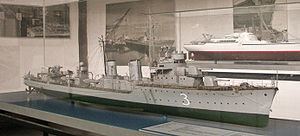Commissioned 30 March 1938 Length 98 m | Namesake Zagreb Out of service 17 April 1941 Draft 3.18 m | |
 | ||
Fate Scuttled by crew on 17 April 1941 Class and type Beograd-class destroyer | ||
The Yugoslav destroyer Zagreb was the second of three Beograd-class destroyers built for the Royal Yugoslav Navy (Serbo-Croatian: Kraljevska Jugoslovenska Ratna Mornarica, KJRM) in the late 1930s. Her main armament consisted of four Škoda 120 mm (4.7 in) guns. When Yugoslavia entered World War II due to the German-led Axis invasion of that country in April 1941, two of her officers scuttled her at the Bay of Kotor on 17 April 1941 to prevent her capture by approaching Italian forces. Both officers were killed by the explosion of the scuttling charges. A French film was made about her demise and the deaths of the two officers. In 1973, on the thirtieth anniversary of the formation of the Yugoslav Navy, both men were posthumously awarded the Order of the People's Hero by President Josip Broz Tito.
Contents
Description and construction
The Beograd class was developed from a French design, and the second ship of the class, Zagreb, was built by Jadranska brodogradilišta at Split, Yugoslavia, under French supervision. The ship had an overall length of 98 m (321 ft 6 in), a beam of 9.45 m (31 ft 0 in), and a normal draught of 3.18 m (10 ft 5 in). Her standard displacement was 1,210 tonnes (1,190 long tons), and she displaced 1,655 tonnes (1,629 long tons) at full load. The ship was powered by Parsons geared steam turbines driving two propellors, using steam generated by three Yarrow water-tube boilers. Her turbines were rated at 40,000 shp (30,000 kW) and she was designed to reach a top speed of 38 knots (70 km/h; 44 mph). She carried 120 tonnes (120 long tons) of fuel oil. Although data is not available for Zagreb, her sister ship Beograd had a radius of action of 1,000 nautical miles (1,900 km; 1,200 mi). The crew consisted of 145 officers and enlisted men.
Her main armament consisted of four Škoda 120 mm (4.7 in) L/46 superfiring guns in single mounts, two forward of the superstructure and two aft, protected by gun shields. Her secondary armament consisted of four Bofors 40 mm (1.6 in) anti-aircraft guns in two twin mounts, located on either side of the aft shelter deck. She was also equipped with two triple mounts of 550 mm (22 in) torpedo tubes and two machine guns. Her fire-control system was provided by the Dutch firm of Hazemayer. As built, she could also carry 30 naval mines. She was launched on 30 March 1938, and was commissioned into the Royal Yugoslav Navy (Serbo-Croatian: Kraljevska Jugoslovenska Ratna Mornarica, KJRM) in August 1939.
Career
At the time of the German-led Axis invasion of Yugoslavia in April 1941, Zagreb and her sister ships were allocated to the 1st Torpedo Division at the Bay of Kotor. From the outbreak of war on 6 April, there were air attacks on the ships and shore installations in the Bay of Kotor, but despite near misses Zagreb was not hit by any bombs. During the days following the invasion, Zagreb and the other ships were moved to different locations within the bay and camouflaged. On 16 April, the ship's crew were informed of the imminent surrender of the Yugoslav armed forces, and were ordered not to resist the enemy any further. The following day, with Italian forces closing on the Bay of Kotor, two junior officers, Milan Spasić and Sergej Mašera, removed the captain and crew from the ship and set scuttling charges to prevent her capture. Both officers were killed in the explosions. Spasić's remains washed ashore on 21 April, and were given a full military funeral by Italian forces on 5 May. Mašera's decapitated head washed up and was secretly buried by locals. The destruction of Zagreb was portrayed in the 1967 French film Flammes sur l'Adriatique (Adriatic Sea of Fire), which was directed by Alexandre Astruc, and starred Gérard Barray. The film was partly filmed on location in Yugoslavia, and was released in France in 1968. In 1973, on the thirtieth anniversary of the establishment of the Yugoslav Navy, the President of Yugoslavia and wartime Partisan leader Josip Broz Tito posthumously awarded both officers the Order of the People's Hero for their courage. In the mid-1980s, Mašera's head was disinterred and forensically identified, after which it was buried at a cemetery in Ljubljana.
